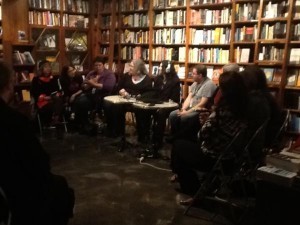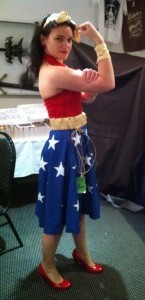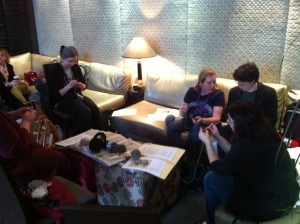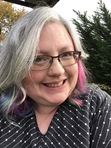Tansy Rayner Roberts's Blog, page 110
June 11, 2012
Galactic Suburbia 61: Craftonomicon
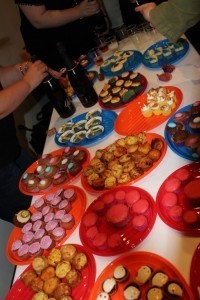 In which we report live and punchy (not enough sleep to be sassy) from Day 2 of Continuum 8: Craftonomicon, Natcon 2012 in Melbourne Australia. Download it IF YOU DARE
In which we report live and punchy (not enough sleep to be sassy) from Day 2 of Continuum 8: Craftonomicon, Natcon 2012 in Melbourne Australia. Download it IF YOU DARE
NEWS
The Con so far: panels, parties, yarn and cupcakes…
What Culture Have we Consumed?
Alisa: Deadline by Mira Grant
Alex: Game of Thrones s1; Dirk Gently’s Holistic Detective Agency; The Courier’s New Bicycle, Kim Westwood (YES ALRIGHT AT LAST)
Tansy: Timeless by Gail Carriger, Cracklescape by Margo Lanagan
Please send feedback to us at galacticsuburbia@gmail.com, follow us on Twitter at @galacticsuburbs, check out Galactic Suburbia Podcast on Facebook and don’t forget to leave a review on iTunes if you love us!
[Photo credit: Cat Sparks]
Tansy’s Con Report 2: Cocktails, Cupcakes and a Trifle or two
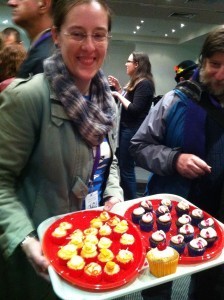 Can’t believe Alex has already managed to write up the whole con! I’m still grouping the events by theme…
Can’t believe Alex has already managed to write up the whole con! I’m still grouping the events by theme…
And speaking of events, there were all manner of special ones at this convention. I was delighted to be able to go to Narrelle Harris’ launch of Walking Shadows, the sequel to The Opposite of Life. This book has been a long time coming, and it was delightful to see it finally HERE. I adore Narrelle, and she deserves all the wonderful writerly things that have been happening for her this year. It was a smallish program room but utterly packed, standing room only (and there were plenty on their feet) as Jason Nahrung launched the books, and we all queued up to buy it. I have a copy!
Speaking of books, I was also excited beyond all measure to get my hot little hands on Medea by Kerry Greenwood, one of my favourite Ancient Greece novels of all time, recently reissued by ClanDestine Press, who are also publishing Narrelle’s novels. I’ve never owned a copy of this book (I read it through the library) but am so excited to have a chance to reread it.
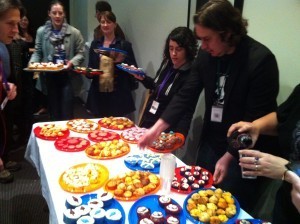 Also on the Friday evening was the Twelfth Planet Hour. I had no idea what was planned or going to happen at this event, which was a semi launch of the new books (Cracklescape by Margo, Through Splintered Walls by Kaaron, plus novella Salvage by Jason Nahrung) and a celebration of Alisa’s five years of publishing. We had to sneak in to set up a table etc. in the Big Room while a panel was on, because of no set up time and the hard deadline of ONE HOUR in which to throw a party. People started arriving faster than expected and somehow I ended up pouring champagne for most of the time which at least meant I got to see many people (briefly) and converse with them (pink, or yellow?).
Also on the Friday evening was the Twelfth Planet Hour. I had no idea what was planned or going to happen at this event, which was a semi launch of the new books (Cracklescape by Margo, Through Splintered Walls by Kaaron, plus novella Salvage by Jason Nahrung) and a celebration of Alisa’s five years of publishing. We had to sneak in to set up a table etc. in the Big Room while a panel was on, because of no set up time and the hard deadline of ONE HOUR in which to throw a party. People started arriving faster than expected and somehow I ended up pouring champagne for most of the time which at least meant I got to see many people (briefly) and converse with them (pink, or yellow?).
The cupcakes started arriving. So many cupcakes. I’ll let Terri tell that story herself as she is the one responsible for the Sea of Cupcakes and has plan to blog each recipe and the story behind it but put simply: she created a cupcake design for each of the books showcased that evening, and they were spectacular. Because of the wild flashmob nature of the party, cupcakes started being eaten almost as soon as they hit the table, and we never got formal pictures, but there are many which capture a slice of the action (heh, you see what I did there?)
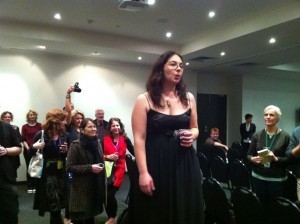 I managed to miss out on both the types of cupcakes that were specific to my books, thanks to being an idiot, but Terri clued me in later. Jason and Alex worked the floor, carrying cupcakes and red wine around to various guests, while Finchy, Sarah and I created the impromptu bar, Alisa sold books hand over fist (they were discreetly placed in the corner just in CASE people wanted to buy them, and the table emptied fast) and Terri quietly hyperventilated on sugar fumes in the corner. She had been baking for days, icing for hours, and deserved a pink champagne more than the rest of us put together.
I managed to miss out on both the types of cupcakes that were specific to my books, thanks to being an idiot, but Terri clued me in later. Jason and Alex worked the floor, carrying cupcakes and red wine around to various guests, while Finchy, Sarah and I created the impromptu bar, Alisa sold books hand over fist (they were discreetly placed in the corner just in CASE people wanted to buy them, and the table emptied fast) and Terri quietly hyperventilated on sugar fumes in the corner. She had been baking for days, icing for hours, and deserved a pink champagne more than the rest of us put together.
Also, there was a juggler from the Women’s Circus. Yes, a juggler. She did a wicked David-Bowie-crystal-ball routine too!
 We’re lucky that so many friends, TPP supporters & helpful passers by helped out with the moving of tables, transporting of drinks and cakes etc, because as it turned out, it wasn’t a LITTLE party, located as it was just before the opening ceremony. It felt like everyone was there (certainly well over 100 when the champagne & cakes were at their most plentiful), and it set a fantastic tone for the rest of the convention – light spirited, bubbly and good natured. Alisa spoke a few words, received much attention, and announced the new crime imprint, Deadlines, which will begin with her 20th book…
We’re lucky that so many friends, TPP supporters & helpful passers by helped out with the moving of tables, transporting of drinks and cakes etc, because as it turned out, it wasn’t a LITTLE party, located as it was just before the opening ceremony. It felt like everyone was there (certainly well over 100 when the champagne & cakes were at their most plentiful), and it set a fantastic tone for the rest of the convention – light spirited, bubbly and good natured. Alisa spoke a few words, received much attention, and announced the new crime imprint, Deadlines, which will begin with her 20th book…
A TRIFLE DEAD by Livia Day.
Now that it’s been announced, I get to come clean too – Livia Day is my new pen name, and the novel in question is mine. It used to be a manuscript under a different title which was nearly published a few years ago, and I have quite a few people who have been waiting to read it for… a while. If the idea of me writing a funny Hobart-based murder mystery romp is intriguing to you then you can read an excerpt in the back of Jason’s novella Salvage… you WERE going to get a copy, right?
pic by Jonathan Strahan, stolen from Twitter
But I’m getting side tracked. The cakefest of Friday night was fabulous, but there was more awesomeness to come.On Saturday afternoon a group of us gathered in Embiggen Bookshop (the most gorgeous and stylish boutique bookshop, Melbournites all need to find this treasure if you haven’t already! I sighed with equal desire for the beautiful bound novels and the fabulous bookshelves, while Finchy was equally captivated by their science and philosophy displays – the shop’s specialty!) to record a podcast in honour of the Twelve Planets series.
Ian Mond hosted, and thanks to the fabulous Kirstyn McDermott and her amazing tech kit, we managed to record a conversation between nine Twelve Planets authors and Alisa herself which felt inspiring and dynamic.
It hadn’t really sunk in before that moment how amazing it is to be in a series of books like this with writers like Margo Lanagan, Lucy Sussex, Deb Biancotti and all the others. Rosaleen Love had us really excited about the book she’s just submitted! It was the first time we’d come together as a group and shared stories about how we individually approached our books (or are going to – so sorry, Deb Kalin, for freaking you out about how much overthinking I did), and what the project meant to us. I came away feeling very humbled and happy and emotional. Luckily there was a trendy bar nearby to help us recover… and possibly Greek food. Mmmm.
I really appreciate the people who came to listen to the live recording! A very friendly audience, which helped relax us all as we passed the microphones back and forth. I hope more people enjoy listening when the podcast was released.
There were other events at the con of course, many many which I didn’t manage to get to, mostly because I was scheduled against them. The Ishtar launch & the Boxcutters debate being two I most regret not being able to see.
But then there was the EVENT on the Sunday night, the colossal awards ceremony, mashing up Chronos Awards, Ditmars, the Chandler, the Peter Mac (the other Peter Mac, not to be confused with the Aurealis Peter Mac) the Hemming, and even a brand new award, the Infinity. Aaaand… I think I’ll save that for part three!
[Alex has blogged AGAIN while I was putting this together - this time with a lovely detailed panel review of the Crafts in Space panel and some other commentary]
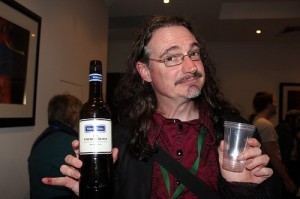
Jason Nahrung: in charge of the red wine at the Twelfth Planet Hour (photo by Cat Sparks)
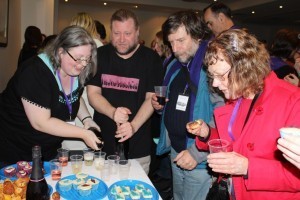
pouring champagne at the Twelfth Planet Hour (photo by Cat Sparks)
Check out the whole Cat Sparx Flickr stream for more images of the con.
Tansy’s Con Report 1: Crafty Continuum, the Program
Rachel Holkner as '1950's feminine ideal Wonder Woman' complete with chatelaine & pincushion
A lovely convention. The title ‘Craftonomicon’ was reflected in two ways – an emphasis on craft threaded through the programme and the repetition of imagery involving squid, octopi and tentacled creatures. I particularly enjoyed the fact that, with great encouragement of the committee and environment, there were crafters everywhere. Those who enjoy handcrafts often feel uncomfortable doing so in public places or audiences, because non-crafters can interpret their busy hands as being rude or dismissive of what’s going on around them. But the reason handcrafts appeal is often because you’re the sort of person who better pays attention when your hands are busy!Right from the beginning, it was clear that this was an event that welcomed and encouraged crafty activity. There were random balls of yarn and needles placed around for people to play with, and the beautiful programme included some patterns and ideas. My very first panel, Crafty Characters on the Friday afternoon, involved a small group of people including the panellists (myself, Trudi Canavan and Jo Spurrier) working away at our crafts while chatting about the topic at hand. We sat around a big round table with our handful of audience members, many of whom had also brought handcrafts to work on while we all discussed the topic. It was a lovely way to get started!
the Twelfth Planet beta crocheters
Other crafty meet-ups (at which I worked away on my paper piecing Doctor Who quilt – I’ll update separately about its progress in another post) included a Twelfth Planet crochet pattern beta-test in the bar on Saturday (I went for moral support and quilting, the others were all there with a variety of crocheting skills and had great fun with the project) and ‘Crafts in Space!‘ on Sunday, where Trudi and I joined with Sarah Parker and the wise and wonderful Lyn McConchie at that big round table again to talk about crafting methods and how they would apply to space travel, whether it be zero gravity crochet skills, holodeck stash shopping, or deciding what crafting skills would be most useful to pioneers on new planets. A fabulous, nurturing discussion, and we really enjoyed the format – Trudi and I decided Craftyklatches needed to feature in future conventions, only for Rachel Holkner to tell me later that Continuum totally did that last year.Some other panels I appeared on over the weekend:
Galactic Suburbia – Live Podcast. Great fun, and yes we ARE capable of doing an hour long episode. Will be up sometime this week.
“Playing God – A Guide for Beginners” in which I finally got to meet Michael Pryor, who moderated the worldbuilding discussion with great elegance – other panellists were Trudi Canavan (we were stalking each other this convention), Louise Cusack and GOH Alison Goodman. It was a fun discussion, which showed how different our working methods were, but brought up several key things we all had in common: the use of real history to furnish fantasy worlds being the biggest one!
Readings with Kelly Link, Jenny Blackford and Alan Baxter. We were very lucky that Kelly read us a fascinating sort-of-horror story that is soon to be published, Two Houses. Jenny shared some cat poems with us, deciding understandably that it was far too intimidating to read prose straight after Kelly Link. I read the first piece of The Patrician, and Alan read part of a novella about a King’s Cross murder.
Finally on Sunday there was a crunchy ‘where are all the wonder women‘ discussion on female superheroes with Grant Watson, Russell Blackford and Alice Clarke. We managed to record that one & the sound quality turned out really well so it will be up some time in the next week or so. I enjoyed it very much and it might well have inspired a new blog series in me… we’ll see!
Contrary to Alex’s belief I do like attending panels, and my quilt in progress gave me an excuse to sit in on some! Not as many as I would have liked, and I was particularly sorry to miss the Boxcutters & Outland panels on Saturday afternoon, but I did enjoy The Forgotten Frontier in which Jonathan Strahan, Random Alex & m1k3y were super judgemental (in various entertaining ways) about space opera, and the first hour of The Writer and the Critic live podcast, in which Mondy & Kirstyn were very scathing about Anne McCaffrey’s The Crystal Singer, while Kelly Link & Alison Goodman provided quite reasoned defenses of the work in its historical context.
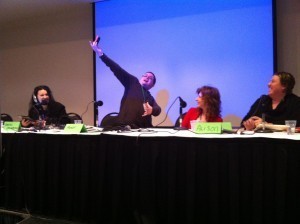 The great thing about the directional microphones used by Kirstyn is that we could heckle from the audience without being heard, and I think mine & Jonathan Strahan’s best achievement on that score was convincing Mondy he had to do a Jim C Hines and re-enact the cover. Sure, you won’t be able to see it on the podcast, but it was a classic photo opportunity, and value-adding for those who were THERE. Several of us had commitments in the second hour and thus got to stage a walk out.
The great thing about the directional microphones used by Kirstyn is that we could heckle from the audience without being heard, and I think mine & Jonathan Strahan’s best achievement on that score was convincing Mondy he had to do a Jim C Hines and re-enact the cover. Sure, you won’t be able to see it on the podcast, but it was a classic photo opportunity, and value-adding for those who were THERE. Several of us had commitments in the second hour and thus got to stage a walk out.
My favourite audience experience, however, was probably the Masters of Podcasting (PODMASTERS) panel, not only because Terry Frost, Alisa, Kirstyn and Jonathan had many interesting stories to share about their podcasting experiences, but because the audience was mostly packed out with all the OTHER Aussie spec fic podcasters (plus two real audience members) and it made for a fun community get together rather than a traditional panel.
All in all, it was a great program – I heard positive things from so many participants and audience members, the most common one being that there were so many things people regretting to not seeing which is the sign of a good con! Possibly my only gripe is that there was no intruction as to how to manage the time which meant the default seemed to be starting & finishing all panels on the hour – leading to a bit of strife & chaos at all beginnings and ends. Also some of the rooms were weirdly hot or cold. But those are minor notes in an otherwise thoughtful & balanced event.
And speaking of events… there were LOTS of them. Will post again later.
June 7, 2012
Twelfth Planet Press Takes On Embiggen Books
If you’re in Melbourne this weekend and not at the Continuum/Craftonomicon convention, you can still get in on some Twelfth Planet Press action!
Hosted by Ian Mond of The Writer and the Critic Podcast, Alisa Krasnostein and a bunch of her authors will be recording a live podcast from Embiggen Books this Saturday afternoon and otherwise causing merriment and mayhem. We’d love to see you there whether you’re a reader, writer, podcast listener or just someone interested in awesome, cute books. For many of you it will be your first chance to get your hands on (or just gaze lovingly at) Through Splintered Walls by Kaaron Warren, and Cracklescape by Margo Lanagan, two brand new books in the Twelve Planets range, plus Salvage by Jason Nahrung, which will be launched at the convention the previous night (TONIGHT)
 Embiggen Books
Embiggen Books
5pm Saturday 9th June (TOMORROW)
197-203 Little Lonsdale St, Melbourne VIC 3000
A book launch with a difference! Come join host Ian Mond, Twelfth Planet Press publisher Alisa Krasnostein and Twelfth Planet Press authors as they launch the Twelve Planets into space, via a live podcast from Embiggen Books. Find out what goes in to putting together this acclaimed series of boutique collections. Hijinks will undoubtedly ensue.
If you’re at the convention, of course, we’d love to have you come along as well! It’s about a 10-15 minute walk from the main con venue, and the more people we have, the better.
Eeee I’m going to be in Melbourne in a few hours.
June 6, 2012
Snapshot 2012: John Richards
 John Richards is a television writer, Doctor Who fan and a regular co-host on the popular TV podcast Boxcutters. With Josh Kinal, he won a Chronos Award for their Aussiecon IV presentation: a live recorded interview with Doctor Who writers Paul Cornell and Robert Shearman. You can find John (occasionally) at The Outland Institute. His 2012 ABC TV sitcom, “Outland,” about five gay science fiction fans (and packed with Dalek jokes) is available now on DVD.
John Richards is a television writer, Doctor Who fan and a regular co-host on the popular TV podcast Boxcutters. With Josh Kinal, he won a Chronos Award for their Aussiecon IV presentation: a live recorded interview with Doctor Who writers Paul Cornell and Robert Shearman. You can find John (occasionally) at The Outland Institute. His 2012 ABC TV sitcom, “Outland,” about five gay science fiction fans (and packed with Dalek jokes) is available now on DVD.
1. Outland, your long awaited TV series about Australian gay SF fans, finally screened this year. What was the reception to the show like, from a mainstream audience, from the queer community, and from science fiction fans? Is there going to be a Season 2?
The reception was both amazing and bewildering. I thought we would have a general ABC comedy reaction, a “well-that-was-nice” sort of thing, but we polarised audiences and press. Reviews were about 80% raves and 20% hated us; audiences broke down into either hardcore groups that watched every week or people who had never heard of us. Non-mainstream gay groups loved it, the Commercial Road mainstream gays didn’t; we had amazing reception from comedy nerds, teenage girls, writers, SF fans and mums. But it was like a heat-seeking missile. Of comedy! Either everyone you knew was watching, or no-one was. The main feedback was of gratitude – so many people were thrilled to finally see themselves on Australian TV. And by themselves I don’t mean gay, or even fans, but people who could see themselves more in Max or Rae than they could in Packed To The Rafters, for example. TV Week had us as pick of the week for episode 4, which was something I never would’ve expected.
2. Outland began as an indie film, and it was the Seattle Gay and Lesbian Film Festival that first screened episodes of the series itself. Do you see yourself writing more work aimed at a film festival audience in the future?
I don’t really think of writing for a specified audience, if I’m honest. I just try to write good. Or at the very least, gooderer. My ideas always seem to have a certain left-of-fieldness to them, though, so I imagine that’s more my world than Channel 9 would be, for example. At the moment I’m trying to work on a one-act play, which I have no idea what I’ll do with when it’s finished.
3. What would be your dream Australian Science Fiction TV show, as a writer or indeed as a viewer?
My dream is that we would make any science fiction for adults at all. I had a meeting with a TV executive recently who seemed terrfied I was going to mention spaceships. He kept saying “no spaceships!”. So obviously now I want to make something about spaceships. I’ve always been interested in doing a Star Trek style thing cast entirely with Indigenous actors – to have some great Aboriginal heroes on screen for kids to look up to. But I’d love to see us do a great Buffy/Almighty Johnsons style series. I think we could do that and get away with it. And I really enjoyed Spirited.
4. What Australian speculative fiction have you loved recently?
I know this is SO out of date, but after years of people telling me I needed to read Peter M. Ball’s “Horn” because it is super-awesome, I finally read Peter M. Ball’s “Horn”. And it was super-awesome. I thought his piece in Sprawl was amazing but hadn’t read Horn until I flew to Sydney a few weeks back – it’s an excellent flight-length. I thought Anywhere But Earth was a great collection, and I loved Narrelle M Harris’s Showtime (but in full disclosure I share a relative with Narrelle so I might be biased).
5. Boxcutters won the Chronos award last year for Best Fan Publication, for the (awesome) special live episode in which you and Josh Kinal interviewed Paul Cornell and Rob Shearman. Will there be a Boxcutters (or indeed, a John Richards) presence at this year’s Continuum?
Yes! Josh and I will be doing a one-on-one debate on the subject that “All Science Fiction Television Is Rubbish”. Josh is the affirmative. He’s clearly going to lose. And Adam and I will be doing a Q&A about Outland which I’m really looking forward to. And I’m doing the Spicks & Speckulations event with George Ivanoff and Narrelle M Harris on Friday night. I’m playing Myf Warhurst.
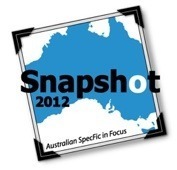 This interview was conducted as part of the 2012 Aussie Spec Fic Snapshot. In the lead up to Continuum 8 in Melbourne, we will be blogging interviews for Snapshot 2012 conducted by Alisa Krasnostein, Kathryn Linge, David McDonald, Helen Merrick, Ian Mond, Jason Nahrung, Alex Pierce, Tansy Rayner Roberts, Tehani Wessely and Sean Wright. To read the interviews hot off the press, check these blogs daily from June 1 to June 7, 2012.
This interview was conducted as part of the 2012 Aussie Spec Fic Snapshot. In the lead up to Continuum 8 in Melbourne, we will be blogging interviews for Snapshot 2012 conducted by Alisa Krasnostein, Kathryn Linge, David McDonald, Helen Merrick, Ian Mond, Jason Nahrung, Alex Pierce, Tansy Rayner Roberts, Tehani Wessely and Sean Wright. To read the interviews hot off the press, check these blogs daily from June 1 to June 7, 2012.
You can find the past three Snapshots at the following links: 2005, 2007 and 2010
Elsewhere on the Internet: Twas the Night Before Craftonomicon
 It’s hard to imagine that there’s anything on the internet except the Aussie Spec Fic Snapshot right now – I’m so proud of the team for being prepared for once (more than a month’s solid work has gone into this year’s effort) and for providing space for so many different voices (all screaming out at once… no wait, that was a different movie). Hooray to Tehani & Kathryn for the organising, and all of our new interviewers. A special big HOORAY for the kind and thoughtful Ben Payne who twigged early on what element was missing from the Snapshot, and provided several-times-daily summaries of the 2012 Snapshot AS – IT – HAPPENED.
It’s hard to imagine that there’s anything on the internet except the Aussie Spec Fic Snapshot right now – I’m so proud of the team for being prepared for once (more than a month’s solid work has gone into this year’s effort) and for providing space for so many different voices (all screaming out at once… no wait, that was a different movie). Hooray to Tehani & Kathryn for the organising, and all of our new interviewers. A special big HOORAY for the kind and thoughtful Ben Payne who twigged early on what element was missing from the Snapshot, and provided several-times-daily summaries of the 2012 Snapshot AS – IT – HAPPENED.
My own snapshot appears here on Random Alex’s blog. And incidentally a blast from the past turned up in my RSS feed, which threw up this old post of Alex’s talking about OMG OUR FIRST PODCAST. I haven’t dared follow the link to find the artefact itself. Dare you?
Nicholas Whyte reviews the Fancast ballot for this year’s Hugo and um. Liked Galactic Suburbia best. May jelly babies rain from the skies upon you, sir!
And I appear again with an essay in Apex Magazine: Girl Meets House. My piece is on my developing enthusiasm for the female Gothic, thanks to Joanna Russ, Sarah Rees Brennan, and a certain indie New Zealand domestic horror film. The piece is available to read free but of course if you want to support small presses and/or read the issue on your e-reader of choice, you can purchase an e-book version very cheaply from the site.
Snapshot 2012: Foz Meadows
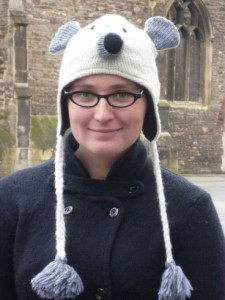 Foz Meadows is a bipedal mammal with delusions of immortality. Author of Solace & Grief and The Key of Starveldt (Ford Street Publishing) Foz currently lives in St Andrews, Scotland, with not enough books and her very own philosopher. You can find her at her blog, on Tumblr and on Twitter as @fozmeadows
Foz Meadows is a bipedal mammal with delusions of immortality. Author of Solace & Grief and The Key of Starveldt (Ford Street Publishing) Foz currently lives in St Andrews, Scotland, with not enough books and her very own philosopher. You can find her at her blog, on Tumblr and on Twitter as @fozmeadows
1. Your recent release, The Key of Starveldt, is the second book in your young adult series ‘The Rare.’ What new challenges did you come across with writing a ‘book 2’?
The main issue I had to deal with in Key was my own enthusiasm: I was so excited to introduce a particular character that I literally raced to their scene without any real plans as to what would happen next, with the result that the first two drafts were mired in narrative dead ends and superfluous detail. The ability to return to existing characters was also very distracting: I had multiple, often contradictory ideas about how I wanted this person or that to develop or what aspects of their backstory would be relevant, so it was quite difficult to pare back their stories to a place where they fit with the existing plot, and didn’t just distract from what was happening.
 2. Solace and Grief, the first book in the series, has been described as a vampire novel which will appeal to people who don’t like the vampire trend. What do you think makes your series stand out among all the teen vampire novels?
2. Solace and Grief, the first book in the series, has been described as a vampire novel which will appeal to people who don’t like the vampire trend. What do you think makes your series stand out among all the teen vampire novels?
Two things: it’s not a romance, and it isn’t set at any sort of school, which seem to be the defining characteristics of the bulk of YA vampire novels. To be clear, I still love a number of stories that fall into both or either category, but when I sat down to write Solace, I wanted it to be less about everyday teenage life than about weirdness and adventure.
Perhaps more pertinently, my own experiences as a teenager make me somewhat less than neutural on the subject of both school and the ever-present love triangle. I find it incredibly difficult, if not outright impossible, to write about high school as a background event rather than politically, as an institution to be challenged or subverted, because of the amount of effort I expended as a student arguing against curricula, grading, subject structure, the allocation of resources, conformity and scare tactics. Similarly, and while I have no objection to other people enjoying them, I have a pathological skepticism of romanticised love triangles, because as a teenager, I was in a love triangle – and believe me, the experience was anything but romantic. The combination of unrequited love angst and profound frustration at the institutional mechanics of education left me severely depressed, routinely insomniac (my last year of school, I survived on an average of four to six hours sleep a night, six days a week), flirting with self harm and regularly contemplating suicide. Somehow, I managed to get through it, but it’s not an experience I’d wish on anyone – and as a consequence, I don’t think I’m capable of writing about school, or love triangles, or especially the two in combination, in any sort of neutural or romantic way.
In that sense, Solace and Grief was as much a book for my teenage self as anything else: a story with a female protagonist who doesn’t go to school, who isn’t in love, and who instead discovers she has awesome powers that make her uniquely capable to try and protect the people she cares about most – her friends, who are right there with her every step of the way.
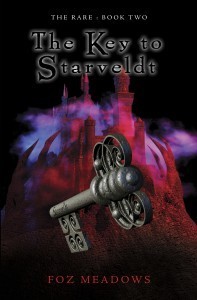 3. Do you find it hard to promote and publicise Australian-published books while living overseas? How important is social media in raising awareness of your books?
3. Do you find it hard to promote and publicise Australian-published books while living overseas? How important is social media in raising awareness of your books?
Extremely! I feel a bit sorry for Key in that respect. Because we couldn’t afford to fly back to Aus when it was released, it didn’t even get a launch, and I couldn’t promote it by doing signings or author events like I did with Solace.
Social media, though, is hugely important in raising awareness not only of your books, but of you as an author – with one caveat. The single biggest mistake I see people making with their online presence is to participate only or mostly as a marketer, rather than as an individual. To quote Nick Harkaway, the internet is not a broadcast medium. The internet is about conversation, about connections, and if the only thing you do with your blog or Twitter or Facebook as an author is to churn out occasional reminders about upcoming or existing publications and where people can buy them, then you’re doing it wrong.
Partly, I think, this is a generational thing: a lot of writers, particularly those in their thirties and twenties, but including many who are older, have grown up with or natively adapted to the internet, and so have an online presence that predates their being published. I blogged as a teenager because that was what you did, and later joined Facebook and Twitter because my friends were already using both and wanted me to come join the fun. Any promotional benefit I now glean from such sites is ultimately secondary to my personal usage of them. Sure, my name and profession are up there, but the vast amount of what I blog, Facebook, tweet and tumble has nothing to do with my writing and everything to do with things I find interesting and want to share or discuss with others. If I like an author’s online presence – if I see them blogging about issues that interest me, discussing tropes on Twitter or generally being awesome – then I’m about 300% more likely to buy their books than if all I ever saw them do was mention that they were an author.
4. What Australian works have you loved recently?
Alas, living in the UK, my access to a lot of Australian works is restricted – I’ve been wanting to read Cassandra Golds’s The Three Loves of Persimmon and Cath Crowley’s Graffiti Moon for ages now. Still, I highly recommend Karen Healey’s The Shattering, (which I reviewed here) and Garth Nix’s A Confusion of Princes.
5. In the last couple of years (since we last did an Australian Spec Fic Snapshot) you’ve become a published author with Ford St Publishing. How has it changed your life?
Mainly, it’s a confidence boost: a reminder that as I’ve done this authoring thing two times now, I can certainly do it a third, and a fourth, and a fifth. I still have just as much doubt and uncertainty about my writing as I always did – maybe more! – but whereas I used to worry that I’d ever be good enough to get published, now I have confirmation. I’ve also been lucky enough to meet, and in some cases even befriend, a number of authors whose work I immensely respect. When I was younger, I didn’t quite realise how important being part of a community of writers could be – I just wanted to tell stories, though there were certainly some authors I’d have given my left arm to meet. Now I get to do both while keeping all my limbs intact, and really, what more do you want?
 This interview was conducted as part of the 2012 Aussie Spec Fic Snapshot. In the lead up to Continuum 8 in Melbourne, we will be blogging interviews for Snapshot 2012 conducted by Alisa Krasnostein, Kathryn Linge, David McDonald, Helen Merrick, Ian Mond, Jason Nahrung, Alex Pierce, Tansy Rayner Roberts, Tehani Wessely and Sean Wright. To read the interviews hot off the press, check these blogs daily from June 1 to June 7, 2012.
This interview was conducted as part of the 2012 Aussie Spec Fic Snapshot. In the lead up to Continuum 8 in Melbourne, we will be blogging interviews for Snapshot 2012 conducted by Alisa Krasnostein, Kathryn Linge, David McDonald, Helen Merrick, Ian Mond, Jason Nahrung, Alex Pierce, Tansy Rayner Roberts, Tehani Wessely and Sean Wright. To read the interviews hot off the press, check these blogs daily from June 1 to June 7, 2012.
You can find the past three Snapshots at the following links: 2005, 2007 and 2010
June 5, 2012
Snapshot 2012: Kate Gordon
 Kate Gordon is a Tasmanian YA author and a very VERY new mum. Check out her blog at www.kategordon.com.au/
Kate Gordon is a Tasmanian YA author and a very VERY new mum. Check out her blog at www.kategordon.com.au/
1. Vulpi, sequel to Thyla, your paranormal-YA-with-weretigers-and-devils has just been released, and I hear that you have switched protagonists for this one. Why is this Cat’s story and not Tessa’s?
Much as I loved writing Tessa, there were so many characters in Thyla whose heads I wanted to delve into. I wanted to give every character their own story and, in fact, when I was writing Thyla, I did create back-stories for each of the characters. Cat fascinated me right from the beginning and I wanted to explore her more. I also thought it would be interesting to see the world of the Thylas from the point of view of several different “people”. The next two books will each have a different protagonist. I have read a couple of series that do this really well – Melissa Marr’s Wicked Lovely series being one example. I think it’s an interesting twist on the way series are usually approached. I understand some people will miss Tessa as a narrator, but hopefully there’s enough of her in Vulpi to satisfy them!
2. Thyla (2011) wasn’t your first novel, but it did launch you as a paranormal/fantasy YA author. Are you pleased with how Thyla was received? How is writing magical stories different from writing about ordinary teenagers?
I’m very pleased with how Thyla was received! I’ve been really lucky. Of course, I was completely frantic before it was released – paranoid that everyone would hate it. I think every author feels like this before a new book comes out, even the old hands! There have been a couple of negative reviews – mainly from people who didn’t realise Thyla was a paranormal book and who dislike the genre – and some great, constructive criticisms (which, as a beginning author, I really value), but on the whole I’ve been just thrilled with the response.
 Writing “magical stories” differs much less than you’d think from writing straight YA (at least, this has been my experience). My novels are very character-driven and my characters have all the same concerns, flaws, foibles and “issues” as “non-magical” teenagers (even if they’re actually two hundred year old immortals!). Creating believable characters is even more important in fantasy and paranormal, because you’re asking the audience to suspend so much disbelief already that it’s imperative that, in the areas where characters, locations or plotlines should be real and relatable, they really, really are. Also, in all my books, I always fall back on the old chestnut of “write what you know”. My writing is chock full of me, my friends, the places I know and love. I love it when my friends and family read my books and recognise themselves, experiences we’ve had together, or little in jokes we share. I think it makes the writing more real to have these little details. So I write what I know in both my paranormal and straight YA. The only difference in the paranormal is I write what I know … and then add shapeshifters!
Writing “magical stories” differs much less than you’d think from writing straight YA (at least, this has been my experience). My novels are very character-driven and my characters have all the same concerns, flaws, foibles and “issues” as “non-magical” teenagers (even if they’re actually two hundred year old immortals!). Creating believable characters is even more important in fantasy and paranormal, because you’re asking the audience to suspend so much disbelief already that it’s imperative that, in the areas where characters, locations or plotlines should be real and relatable, they really, really are. Also, in all my books, I always fall back on the old chestnut of “write what you know”. My writing is chock full of me, my friends, the places I know and love. I love it when my friends and family read my books and recognise themselves, experiences we’ve had together, or little in jokes we share. I think it makes the writing more real to have these little details. So I write what I know in both my paranormal and straight YA. The only difference in the paranormal is I write what I know … and then add shapeshifters!
3. You’ve got two books still to go in this series! How far along are you with writing them and (crucially) how do you think your writing routine is going to change now you have a brand new baby in your life?
I’ve written both of the other books in the Thyla series, to different stages! The next book, Sarco, is with the publisher, and Diemen, the final in the series, is just at first draft stage. I have until September to edit it in order to get it to a stage I’m happy with, in order to fulfil the requirements of my Arts Tasmania grant. When I found out I was pregnant, I went into writing overdrive, knowing that when I had Tessa (yes, she does have the same name as Thyla’s protagonist!), she’d immediately become my number one priority and focus. And that holds true. Now she’s here, she’s definitely number one! That said, I have been doing a bit of writing every day since I was well enough to, following the birth (she’s been out ten days as I write this). I do it only for about half an hour a day, and it’s my “me” time. Tessa is in the nursery at the moment as she’s a bit premature, and will be here for the next few weeks. Who knows how things will change once she’s home! It will be a huge learning curve (but an amazing one). It’s good to know I still do have the drive to write, though, and I don’t think that will go away. I do have a deadline in a month or so, and it’s that I’m working on now, but I had the manuscript to a pretty good state before Tessa’s unexpectedly early arrival. And I have another exciting project with a great writer friend of mine but, as a mother herself, she’s happy to let that just simmer while I adjust to my new role. Writing will always be a huge part of my life – and, of course, it’s my career – but I figure most people take a few months’ maternity leave, don’t they? So if I’m a bit less productive for the next little while, I’m sure people will understand! After that, I’ll write while she sleeps. It’s still such a huge part of who I am. I’ll never fully give it up. And you never know, Tessie might well just be the biggest inspiration I’ve ever had!
4. What Australian works have you loved recently?
What Australian works haven’t I loved lately? Honestly, I think this is just about the best time in the history of Australian YA spec fiction. The number of amazing writers out there doing fantasy, paranormal and science fiction is just unbelievable! I just adored Penni Russon’s award-winning Only, Ever, Always. So beautifully, poetically written and yet utterly readable and absorbing. Definitely a one-sitting-er! Ben Chandler’s fab steampunky fantasy novel, Quillblade was also completely addictive and so unique. He’s got a wonderfully twisty turny brain, that one! Nansi Kunze’s hip teen sci fi, Dangerously Placed reignited my interest in science fiction and Marianne de Pierres’ Burn Bright and Angel Arias just astonished me with their dark, gothic and completely one-of-a-kind approach to the paranormal genre. Oh, and Leanne Hall’s This is Shyness and its sequel, Queen of the Night deserved every skerrick of hype they were given. There are too many other great titles that I’m forgetting, too! Every time I go to a bookshop I am completely spoiled for choice!
5. The last question is supposed to be about how the spec fic scene has changed since the last Snapshot (and Aussiecon 4) two years ago, but you weren’t even a published author then! You were a bookseller, though, before your first novel Three Things About Daisy Blue was released in late 2010. How do you think publishing and the book industry has changed in that time?
I wasn’t a published author when the last Snapshot was taken, but I had worked in bookshops and libraries for many years and I’ve been witness to a great many changes during that time. I’ve watched realistic YA have its heyday, “witch and wizard” books have their heyday in the aftermath of Harry Potter, and fantasy take off on the dragon back of Eragon. I worked in a boys’ school when the Cherub and Stormbreaker spy series became huge. And I was in a bookshop again when Twilight sunk its teeth into the neck of the publishing industry and brought vampires back from the dead. The publishing industry is always after a new trend. Paranormal seems to be slightly on the decline, dystopias are huge now, and there are signs that realistic YA is having a resurgence, spearheaded by the superlative John Green. Of course, it isn’t just wars of the genres that are happening in the publishing industry. Ebooks versus paper; traditional publishing versus self-publishing; bookshops versus virtual stores – it’s an exciting time to be in the book world, but also a scary one. What’s going to happen next? The industry is in a state of flux and huge transformation and traditional houses, authors and readers alike are fighting to come to grips with it all. In the end, I think, the power of the story will always win out. People will always want to read; it just depends how they do it. We’ll work it out, as an industry, and before we know it these years of change and uncertainty will be a distant memory. And, before long, the only thing we’ll be worried about – again – is whether mermaids or fairies are the next big thing!
 This interview was conducted as part of the 2012 Aussie Spec Fic Snapshot. In the lead up to Continuum 8 in Melbourne, we will be blogging interviews for Snapshot 2012 conducted by Alisa Krasnostein, Kathryn Linge, David McDonald, Helen Merrick, Ian Mond, Jason Nahrung, Alex Pierce, Tansy Rayner Roberts, Tehani Wessely and Sean Wright. To read the interviews hot off the press, check these blogs daily from June 1 to June 7, 2012.
This interview was conducted as part of the 2012 Aussie Spec Fic Snapshot. In the lead up to Continuum 8 in Melbourne, we will be blogging interviews for Snapshot 2012 conducted by Alisa Krasnostein, Kathryn Linge, David McDonald, Helen Merrick, Ian Mond, Jason Nahrung, Alex Pierce, Tansy Rayner Roberts, Tehani Wessely and Sean Wright. To read the interviews hot off the press, check these blogs daily from June 1 to June 7, 2012.
You can find the past three Snapshots at the following links: 2005, 2007 and 2010
Snapshot 2012: Claire Corbett
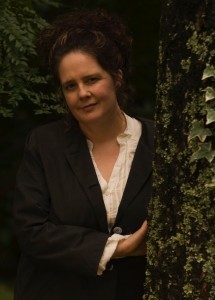 Claire Corbett crewed on films before becoming a policy advisor in the NSW Cabinet Office. She worked on water and genetically modified organisms for the Environment Protection Authority and child and family health for NSW Health.
Claire Corbett crewed on films before becoming a policy advisor in the NSW Cabinet Office. She worked on water and genetically modified organisms for the Environment Protection Authority and child and family health for NSW Health.
Claire has had stories broadcast on Radio National and published in Splash (Penguin), Picador New Writing and The Sydney Morning Herald, among others. She completed a Varuna Mentorship in 2000.
When We Have Wings, a novel about humans genetically engineered to fly, was published by Allen & Unwin in July 2011 and shortlisted for the 2012 Barbara Jefferis Award. It is also being published in the Netherlands, Spain, Portugal and Russia.
1. Your recent debut novel, When We Have Wings, is about a world where society is divided sharply into those who can fly and those who cannot. What is it about flight that caught your imagination so strongly? Given the choice, is this something you would want for yourself?
I used to have powerful flying dreams; it was as if I knew how it felt to fly. I wanted to escape aspects of my life. The desire to fly was a yearning for freedom, which I imagine it is for most people. As a child I lived in the foothills of the Rocky Mountains where there were many hawks and eagles. I was transfixed by, and so jealous of, they way they could just launch themselves off cliffs and soar effortlessly. I don’t know if I’d go through the trouble and effort of becoming a flier now but at age five, twelve, seventeen, twenty-five? You bet I would! There are always people eager to push the envelope in any way they can. At a CSIRO tweetup for the launch of the Mars Rover Curiosity, we were asked how many of us would volunteer to travel to Mars if we knew we wouldn’t come back. Many people, perhaps the majority, put up their hands.
2. What did it mean to you to be shortlisted for the Barbara Jefferis Prize?
It means so much to me. To be shortlisted from 55 books for my debut novel with five of Australia’s most acclaimed writers – Frank Moorhouse, Georgia Blain, Gillian Mears, Anna Funder and Gail Jones – feels like ‘arriving’. To have judges as formidable, experienced and discriminating as Sophie Cunningham and Debra Adelaide really ‘get’ my novel made me feel that I’d achieved everything I set out to do.
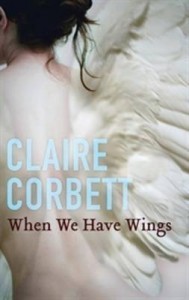 3. Is your next project also science fictional? What can you tell us about what you’re working on now?
3. Is your next project also science fictional? What can you tell us about what you’re working on now?
Yes. It’s daunting to tackle because it’s another complex book that is going to take a lot of research. I can say that it deals with the sublime, the idea of beauty and terror, which I also worked with in When We Have Wings. There are no fliers in it as far as I know but it is set in the near future.
4. What Australian works have you loved recently?
Great question. Since being published last year I’ve read more Australian books than I have in years. There’s so much good work around that we seem to be entering a golden period. Recently I’ve read and really enjoyed Charlotte Wood’s Animal People, Margo Lanagan’s Yellowcake and Red Spikes (and looking forward to Cracklescape and Sea Hearts), Gillian Mears’ Foals’ Bread, the Coeur de Lion collection Anywhere But Earth, Chloe Hooper’s The Tall Man, PM Newton’s The Old School, Kirsten Tranter’s A Common Loss, Marie Munkara’s Every Secret Thing, Ruby Langford Ginibi’s Don’t Take Your Love to Town and Jessica Anderson’s Tirra Lirra by the River (hardly a recent book, I know). I also thought Peter Docker’s The Waterboys was one of the most interesting and ambitious Australian SF novels I’ve read. I’ve just finished reading Meg Mundell’s Black Glass and I loved that; it’s beautifully written, touching, believable and also has interesting ideas and images.
5. A lot of your writing experience is in feature films. How is writing a novel different to writing a film script?
My experience in feature films is mostly in the cutting room as an assistant editor, which taught me a lot about structure and story. I’ve always worked as a prose writer first and foremost; writing scripts never used to appeal to me. There’s not much beauty in a film script and I was all about the beauty of a sentence.
Now that I’m more experienced I realise how much I’ve learned about structure from film and that the gulf between writing novels and making films isn’t as vast as scriptwriters and novelists would have you believe. Character and story are key, as is good dialogue. I picked up a book by a famous novelist the other day and quickly put it back when I saw it had almost no dialogue. You lose so much if you don’t write good dialogue, including humour, and the ability to show your characters’ relationships economically. When Jane Campion read the book, she told me she particularly loved the dialogue and that meant so much to me, coming from a film director.
Of course one of the great differences between the forms is that it is so easy to ‘show’ rather than ‘tell’ in film and this particularly relates to SF and fantasy. SFF books are often long because the wild and wonderful aspects of their invented reality have to be described. In film it’s so easy and economical to show these fabulous worlds. Virtually every review and comment I’ve had has said how visual the book is, how much they’d like to see it as a film, and I guess this could be partly a result of my training, both in thinking visually and in paying attention to how people speak. You spend most of your time in the cutting room listening to dialogue and music – it’s an aural environment almost more than a visual one. I describe that in an essay (‘Cutting it Fine’) in Piano Lessons, a book of essays on The Piano published by Southern Screen
Classics.
I’ve wondered if this is why SFF is one of the most popular film genres and yet still disliked by so many readers. Somehow the wonder is experienced through film without being alienating. Film, like Robert Heinlein’s Moon, is a harsh mistress. The Piano was an arthouse film but its running time had to be no longer than 95 minutes
including credits. There’s pain and whole scenes are dropped on the way to a fine cut. I learned a lot about discipline from that. Jane focused on ‘what does the film need?’ and when I write, particularly when editing, I try to focus on ‘what does the book need?’
 This interview was conducted as part of the 2012 Aussie Spec Fic Snapshot. In the lead up to Continuum 8 in Melbourne, we will be blogging interviews for Snapshot 2012 conducted by Alisa Krasnostein, Kathryn Linge, David McDonald, Helen Merrick, Ian Mond, Jason Nahrung, Alex Pierce, Tansy Rayner Roberts, Tehani Wessely and Sean Wright. To read the interviews hot off the press, check these blogs daily from June 1 to June 7, 2012.
This interview was conducted as part of the 2012 Aussie Spec Fic Snapshot. In the lead up to Continuum 8 in Melbourne, we will be blogging interviews for Snapshot 2012 conducted by Alisa Krasnostein, Kathryn Linge, David McDonald, Helen Merrick, Ian Mond, Jason Nahrung, Alex Pierce, Tansy Rayner Roberts, Tehani Wessely and Sean Wright. To read the interviews hot off the press, check these blogs daily from June 1 to June 7, 2012.
You can find the past three Snapshots at the following links: 2005, 2007 and 2010
June 4, 2012
Snapshot 2012: Kirstyn McDermott
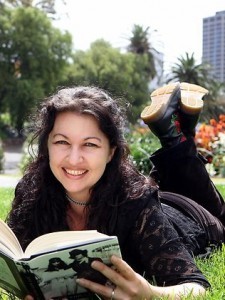 Kirstyn McDermott’s short fiction has been published in various journals, magazines and anthologies in Australia and overseas. Her debut novel, Madigan Mine, received an Aurealis Award for Best Horror Novel, and her second, Perfections, is due out later this year. She lives in Melbourne with her husband and fellow scribbler, Jason Nahrung, and can be found online at www.kirstynmcdermott.com
Kirstyn McDermott’s short fiction has been published in various journals, magazines and anthologies in Australia and overseas. Her debut novel, Madigan Mine, received an Aurealis Award for Best Horror Novel, and her second, Perfections, is due out later this year. She lives in Melbourne with her husband and fellow scribbler, Jason Nahrung, and can be found online at www.kirstynmcdermott.com
1. The Writer and the Critic has become an integral part of the Aussie spec fic scene very fast – and you don’t even talk about spec fic books all the time! What does podcasting offer you, as a social medium or a creative one?
For one thing, it gives me a chance to review and talk about books. It sounds simplistic but somehow I never find the time to actually sit down and write reviews these days, let alone the sort of substantial, in depth critiques that The Writer and the Critic affords me. Of course, it does mean that “reading” for me has now been shifted across into the “work/obligation” box, but I’m learning to live with that. And I’ve realised what a highly critical reader I am … now when I read a book, my filter is generally, “Can I talk about this for half an hour on the podcast?” If the answer is, “No,” as it very often is, I’m afraid I find myself resenting that book rather a lot more than I might have a couple of years ago. Maybe that’s not really fair, but it does remind me that life is way too short to read anything less than brilliant books.
As a natural introvert – yes, really! – I also deeply appreciate the social interaction that seems to go hand in hand with podcasting. Both the feedback from our listeners and the ongoing banter that happens between various podcasters both here in Australia and internationally. I love the spec fic community and it feels great to be able to contribute to and help build that community. Ever since I stumbled upon my first fanzine a couple of decades ago, I’ve toyed off and on with the idea of publishing one of my own. Problem is, I really don’t have the time, patience or spare words to successfully do that on a regular basis – it’s been hard enough maintaining an online blog and so on while still finding time to write my fiction. Podcasting is definitely a quicker and easier medium for me, production wise, and I’m very glad that Ian was finally able to talk me into it.
2. Since the last Snapshot, you had your first novel, Madigan Mine published! What was that experience like, and how have things changed for you since then?
It was a steep learning curve, is what the experience was! People always tell you that, but somehow it’s even steeper and curvier than you imagined it would be. One thing I wasn’t really prepared for was the need to juggle all the work that happened around the publication of the Madigan Mine with the writing of the next book (or the writing of much else, to be honest). That’s something I think I’ll be better at the next time around; or at least not quite so bad at. We’ll see.
As for changes, well. I did finally manage to finish what I have come to think of as My Difficult Second Novel, and am right about to start the edits on that. It’s real name is Perfections and I don’t think I have ever hated writing anything so much as I hated writing that book for the longest, longest time. It was just this awful thing
which refused to be what I wanted to it be, or do anything I wanted it to do, and I almost abandoned it several times. But then I started listening to it, and letting it be itself – which is a contemporary gothic fairy tale of sorts – and now I love it. Albeit grudgingly. We’re probably going to have a love-hate relationship forever, that book and me. But it’s much better than Madigan Mine; more intricate, more complex, more mature. And darker, much darker. With Perfections, I think I can actually call myself a novelist. Before that I was a short story writer who accidentally managed to finish a novel somehow. Now, with two of the beasts beneath my belt, the prospect of beginning my third at the end of this year is much less daunting. I know I’m able to write it, and I know that if I end up loathing it somewhere in the middle, all I really need to do is press on until the end and see how what happens. I really didn’t have that confidence before.
3. A little bird tells me you have a collection of short stories due out soon, as part of the Twelve Planets series! What will we see in this book that we haven’t seen from you before?
Yes, I do and I’m very excited about it! The Twelve Planets volume has given me the space to stretch myself with a couple of novellas – a notoriously difficult size to find a home for – and to think about how the different stories will complement each other. My stories aren’t interlinked like some of the Twelve Planets have been, but I think their themes and tones work harmoniously together. (Or discordantly … depending on your taste.) I’m in the middle of finishing the final novella now and it’s horrible, really horrible. I think the research broke me. But “horrible” really isn’t new for me, is it? Hmm. How about this: one of my stories in this collection has a happy ending. Well, not in the kittens and rainbows way, but still, optimistic. Yep, I’m going with
optimistic. I’m not sure I’ve ever quite managed that before …
4. What Australian works have you loved recently?
Sea Hearts by Margo Lanagan is brilliant, absolutely brilliant. Also, The Courier’s New Bicycle by Kim Westwood, which I was delighted to see win the Aurealis Award for Best Science Fiction novel recently, and the Ishtar anthology which features three novellas by Kaaron Warren, Deborah Biancotti and Cat Sparks. Then there are my
two favourite collections of last year, Bluegrass Symphony by Lisa L. Hannett and The Last Days of Kali Yuga by Paul Haines, which are both exquisite.
Plus, having just judged the horror category for Aurealis, I’ve read some excellent short fiction in the past twelve months. As well as the stories which made the final shortlist, I’d like to give a shout out to a few more which rated very highly on my personal long list: “At The Top Of The Stairs” by Richard Harland, “Letters of Love
from the Once and Newly Dead” by Christopher Green, “Say Zucchini and Mean It” by Peter M. Ball, “The List of Definite Endings” by Kaaron Warren, and “Lamia Victoriana” by someone called Tansy Rayner Roberts. Well worth tracking down, the lot of them.
5. Two years on from Aussiecon 4 (and the last Snapshot), what do you think are some of the biggest changes to the Australian Spec Fic scene?
That’s a really difficult question, because it’s not something I tend to reflect upon. What I have seen over the past couple of years is a rise – or perhaps the resurgence – of a DIY mentality in the scene. Podcasts and new fanzines are launching, small presses are ramping up their ambition and output, and a lot of authors – both emerging writers and those more established – are experimenting with digital publishing, self-publishing and new media. There seems to be a real confidence in the scene right now, a lot of optimism for future opportunities, or at least that’s what I feel among the people with whom I find myself interacting these days. And it seems to be working, because a lot of Australians are popping up on international awards ballots and in year’s best collections, being widely published outside of Australia, and generally garnering favourable notice beyond our shores. The internet has made the world smaller, but it’s also a much noisier place now, and it’s great to see Australian voices rising above the madding crowd. More importantly, I think, it’s great to see them remaining Australian voices, telling our stories in our words. I love that.
 This interview was conducted as part of the 2012 Aussie Spec Fic Snapshot. In the lead up to Continuum 8 in Melbourne, we will be blogging interviews for Snapshot 2012 conducted by Alisa Krasnostein, Kathryn Linge, David McDonald, Helen Merrick, Ian Mond, Jason Nahrung, Alex Pierce, Tansy Rayner Roberts, Tehani Wessely and Sean Wright. To read the interviews hot off the press, check these blogs daily from June 1 to June 7, 2012.
This interview was conducted as part of the 2012 Aussie Spec Fic Snapshot. In the lead up to Continuum 8 in Melbourne, we will be blogging interviews for Snapshot 2012 conducted by Alisa Krasnostein, Kathryn Linge, David McDonald, Helen Merrick, Ian Mond, Jason Nahrung, Alex Pierce, Tansy Rayner Roberts, Tehani Wessely and Sean Wright. To read the interviews hot off the press, check these blogs daily from June 1 to June 7, 2012.
You can find the past three Snapshots at the following links: 2005, 2007 and 2010

